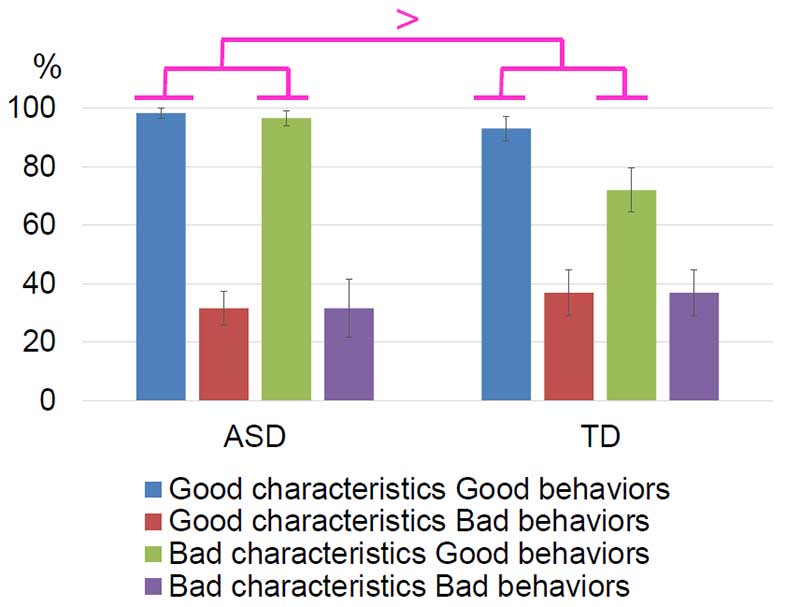Behavior-based moral judgment in early adolescents with and without autism spectrum disorders
Autism spectrum disorder (ASD) is characterized by problems with reciprocal social interaction, repetitive behaviors/narrow interests (American Psychiatric Association, 2013), and impairments in the social cognition and emotional processing necessary for intention-based moral judgements (Moran et al., 2011).
We examined the information used by early adolescents (mean age = 12.4 years) with and without ASD when they judge story protagonists as good or bad. We created stories consisted of three sentences (first sentence: characteristics; second sentence: behaviors; and third sentence: outcomes). In Experiment 1, we measured sentence by sentence reading times and percentages for good or bad judgements. In Experiment 2, two stories were presented and the participants determined which protagonist was better or worse.
Experiment 1 results showed that the adolescents with ASD used protagonist behaviors and outcomes, whereas the TD adolescents used protagonist characteristics, behaviors, and outcomes. Interestingly, as shown in the Figure 1, in the judgement of a person with "bad characteristics, good behaviors, with good outcomes", the ASD group judged "Good person" more than the TD group did ( F (1, 37) = 10.90, p = .00, η p 2 = .23). Additionally, in the ASD group, the outcome-sentence reading times for bad characteristics with good behaviors (3295.3msec.) were longer than those for good characteristics with good behaviors (2725.0 msec.; F (1, 18) = 7.20, p = .02, η p 2 = .29).
In Experiment 2, TD adolescents used characteristics information more than the adolescents with ASD when making "bad" judgements (comparison in the bad outcome stories). The group × outcomes interaction was significant ( F (1, 37) = 4.23, p = .05, η p 2 = .10), and more behavior-based judgements were made for good outcomes than for bad outcomes in the TD group ( F (1, 19) = 5.17, p = .03, η p 2 = .21). The pattern of findings suggests that for bad outcomes, the TD adolescents used characteristics information (21.4%) in the bad outcome more than adolescents with ASD (9.6%) in the bad outcome. Thus, the TD adolescents used characteristics-based information during their decision-making processes based on social conventional rules.
Taken together, in situations in which participants cannot go back and assess (Experiment 1), and in comparable situations in which all information is available (Experiment 2), adolescents with ASD do not rely on information about characteristics when making moral judgements.

Figure 1. Percentages of "good" judgments in Experiment 1
The blue bar shows good characteristics with good behaviors, the red bar shows good characteristics with bad behaviors, the green bar shows bad characteristics with good behaviors, the purple bar shows bad characteristics with bad behaviors.
Good and bad outcomes were collapsed to show the interaction between characteristics and behaviors.
The number of "good" responses for good behaviors was greater in the ASD group than in the TD group.
Error bars represent 95% confidence intervals.
Paper Information
【DOI】 http://dx.doi.org/10.1038/srep37875
【KURENAI ACCESS URL】 http://hdl.handle.net/2433/217452
Hidetsugu Komeda, Hidekazu Osanai, Kaichi Yanaoka, Yuko Okamoto, Toru Fujioka, Sumiyoshi Arai, Keisuke Inohara, Masuo Koyasu, Takashi Kusumi, Shinichiro Takiguchi, Masao Kawatani, Hirokazu Kumazaki, Michio Hiratani, Akemi Tomoda & Hirotaka Kosaka. (2016). Decision making processes based on social conventional rules in early adolescents with and without autism spectrum disorders. Scientific Reports, 6: 37875.





